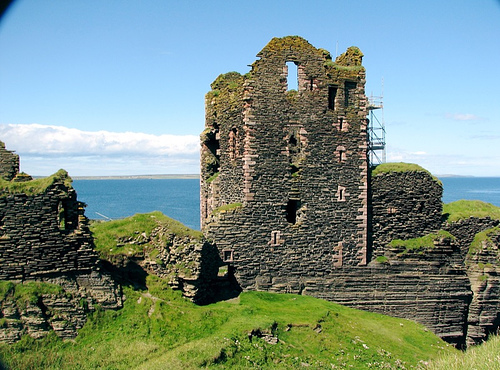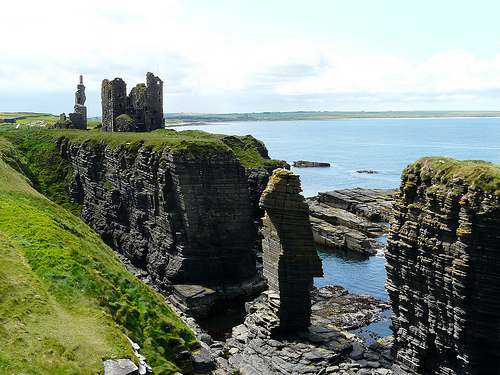

Location: Wick,Caithness Map
Constructed: 1476- 1496
Castle Sinclair Girnigoe, perched dramatically on the cliffs overlooking Sinclair Bay near Wick in Caithness, Scotland, is a striking ruin that encapsulates centuries of Highland history, clan power, and architectural evolution. Located approximately 3 miles north of the town, it stands as one of the earliest and most significant seats of Clan Sinclair, a family that wielded immense influence across northern Scotland and the Orkney Isles. Comprising the remnants of what was once thought to be two distinct castles—Castle Girnigoe (15th century) and Castle Sinclair (early 17th century)—modern archaeology has revealed it to be a single, evolving fortress modified over 200 years. Now maintained by the Clan Sinclair Trust, this scheduled monument offers a hauntingly beautiful glimpse into Scotland’s medieval and Renaissance past, set against a rugged coastal backdrop.

The castle’s origins date to the late 14th century, likely around
1379, when Henry Sinclair, 1st Earl of Orkney, established a
stronghold on this rocky promontory. The Sinclairs, of Norman
descent, had risen through strategic marriages, notably Henry’s
union with the daughter of the last Norse Earl of Caithness,
securing their foothold in the north. Initially called Castle
Girnigoe—possibly derived from a Norse term for “steep ravine” or a
nod to its precarious perch—the fortress was built to assert control
over Caithness and protect against sea-borne threats from Vikings or
rival clans like the Gunns and Sutherlands.
By 1455, William
Sinclair, 2nd Earl of Caithness, expanded Girnigoe, constructing the
tower house between 1476 and his death at the Battle of Flodden in
1513. This L-plan keep, with its thick walls and defensive ditch,
reflected the era’s need for security amid clan feuds and English
incursions. His son, John, 3rd Earl (d. 1529), continued the work,
adding domestic ranges, but died fighting in Orkney, leaving
Girnigoe as the family’s chief residence.
The 16th century brought both grandeur and grim tales. George Sinclair, 4th Earl of Caithness (d. 1582), known as “Wicked George,” rebuilt much of the castle, making it a symbol of Sinclair dominance. His reign was marked by cruelty, most notoriously in 1577 when he imprisoned his son, John, Master of Caithness, in Girnigoe’s dungeons for seven years on suspicion of rebellion. Denied water and fed only salted beef, John died insane from thirst—a chilling episode etched into the castle’s lore. George also feuded with the Earl of Sutherland, besieging Wick in 1588, though Girnigoe withstood a 12-day counter-siege.
In 1606, George Sinclair, 5th Earl of Caithness, petitioned the Scottish Parliament to rename Girnigoe as Castle Sinclair, reflecting his additions: a gatehouse, curtain wall, and outer ward connected by a drawbridge over a deepened ravine. This Renaissance expansion transformed the fortress into a grand residence, with luxurious interiors—gold and silver vessels, embroidered hangings—befitting the Sinclairs’ status as Earls of Caithness and Orkney. Yet, George’s feuds persisted, including suppressing an Orkney rebellion in 1615, maintaining Girnigoe’s martial role.
The castle’s fortunes shifted in the 17th century. In 1651, Cromwell’s troops occupied Girnigoe during the Third English Civil War, damaging it as a base against Royalist clans. After their withdrawal, George, 6th Earl (d. 1676), died childless, sparking a succession crisis. John Campbell of Glenorchy claimed the earldom through marriage to George’s widow, but George Sinclair of Keiss, a cousin, contested this. In 1679, Sinclair of Keiss besieged Girnigoe, stripping its roofs, doors, and furniture, weakening its structure. The dispute culminated in the 1680 Battle of Altimarlach, where Campbell’s forces triumphed, though Sinclair reclaimed the earldom in 1681. A final assault in 1690 by Sinclair of Keiss, using cannon fire, left Girnigoe a ruin, abandoned as cliffs eroded beneath it.
For centuries, the castle decayed, its cliffs crumbling into the North Sea. In 1998, the Clan Sinclair Trust was formed to save it, spurred by its 2002 listing on the World Monuments Fund’s 100 Most Endangered Sites—the only Scottish castle so honored. Archaeological work by Field Archaeology Specialists (2003) clarified its single-castle identity, while stabilization efforts, backed by Historic Scotland and the Heritage Lottery Fund, reinforced walls and added a footbridge. King Charles III, the Trust’s patron, supports this ongoing mission. As of April 11, 2025, the ruins remain a public site, their preservation balancing history with nature’s relentless advance.
Castle Sinclair Girnigoe is a complex ruin, its layout reflecting centuries of adaptation on a narrow, cliff-bound peninsula jutting into Sinclair Bay. Built of local Caithness flagstone—a dark, fissile sandstone—it comprises a tower house, outer ward, and defensive works, now fragmented but evocative.
The tower house, begun in the late 15th century, is the castle’s
medieval heart:
An L-plan structure, five stories tall
(originally 15 meters/50 feet), with 2-meter-thick walls, it sits at
the promontory’s eastern end. The basement, vaulted and half-buried
due to sloping ground, housed a kitchen with a fireplace and a
secret chamber in its ceiling—perhaps for hiding valuables.
The
first-floor hall, accessed via an external stair (now gone), spanned
10 x 5 meters, with a hearth and window seats offering sea views.
Upper floors held private chambers, their crow-stepped gables a
Scottish hallmark, though roofs collapsed post-1690.
A dungeon,
carved into the rock beneath, held prisoners like John, Master of
Caithness, its dank, bottle-shaped cell accessible only by a hatch.
The early 17th-century outer ward, added by George, 5th Earl,
extends westward:
A curtain wall, pierced by arrow slits,
encloses a courtyard with domestic ranges—bakehouse, brewhouse, and
lodgings—now reduced to foundations. A gatehouse, with a
barrel-vaulted passage, once supported a drawbridge over a
10-meter-wide, rock-cut ditch.
The West Gatehouse, misnamed
“Castle Sinclair” in early accounts, retains a chimney stack and
wall fragments, its upper floors lost. It linked to the tower via a
second drawbridge, replaced by a modern wooden bridge in 2008.
A
barbican at the landward end, with a corbelled parapet, guarded the
approach, its remnants teetering on the cliff edge.
The castle’s position is its greatest defense:
Surrounded by
30-meter (100-foot) cliffs on three sides, it was near-impregnable
from the sea. A deep ditch, cut through the peninsula’s neck,
severed it from the mainland, with drawbridges (now gone)
controlling access.
Gun loops and a hornwork, added in the 1600s,
countered artillery, though 1690’s cannon fire breached these
defenses, shattering the outer ward.
The ruins are skeletal but striking. The tower house stands tallest, its eastern wall intact, while the outer ward’s walls crumble into the sea. Erosion has claimed chunks of the promontory, with keystones destabilized, prompting Trust interventions—masonry consolidation, cliff reinforcement—since 2003. The 2008 footbridge ensures safe entry, though much remains fenced off for safety.
The castle’s setting amplifies its drama:
Cliffside Peninsula:
Jutting 100 meters into Sinclair Bay, the site is surrounded by
crashing waves, with stacks and arches carved by erosion. A small
cove below, accessible via a steep path, reveals a shingle beach
where visitors stack cairns.
Coastal Views: From the ruins,
Sinclair Bay stretches south to Reiss Beach, while Noss Head
Lighthouse looms a mile north. The North Sea’s horizon hints at
Orkney, 50 miles away, tying the castle to Sinclair’s island legacy.
Mainland Approach: A 10-minute walk from the Noss Head car park
crosses sheep-grazed fields, with a farm track leading to the cliff
edge. Information boards along the path detail history, geology, and
wildlife—skylarks, puffins, seals—enhancing the journey.
Natural
Context: Heather moorlands and gorse fringe the coast, with the
Caithness plateau’s flat expanse inland contrasting the cliffs’
verticality. No formal gardens exist, suiting the site’s wild,
windswept character.
The grounds, part of the North Coast 500
route, offer solitude and spectacle, their ruggedness echoing the
castle’s past.
Castle Sinclair Girnigoe is a Highland icon, weaving history, clan
lore, and modern resonance:
Sinclair Legacy: As a seat of the
Earls of Caithness and Orkney, it reflects the Sinclairs’ power
across northern Scotland, from Kirkwall to Roslin (Rosslyn Chapel).
Artifacts like a 1496 charter, signed at Girnigoe, tie it to their
feudal might.
Gruesome Tales: The imprisonment and death of John,
Master of Caithness, fuel its dark reputation, a cautionary tale of
familial betrayal. Feuds with Gunns and Sutherlands, like the 1588
Wick siege, cement its martial mythos.
Renaissance Splendor:
Descriptions of “halls hung with embroidered hangings” and “gold
vessels” (c. 1600s) evoke a lost opulence, contrasting its current
decay.
Preservation Triumph: The Clan Sinclair Trust’s work,
backed by global recognition (World Monuments Fund, 2002), showcases
community dedication. King Charles III’s patronage underscores its
national value.
Tourist Draw: Its Game of Thrones-like ruins and
NC500 prominence attract adventurers, historians, and photographers,
boosting Wick’s economy. Its cliffs and lore inspire art, from
paintings to travel blogs.
The castle bridges medieval brutality
with modern stewardship, its silhouette a Highland emblem.
Located at KW1 4QT, the castle is a 5-minute drive north of Wick via
the A99, then a right onto the Noss Head road. From Inverness (110
miles, 2.5 hours), take the A9; Wick’s train station (4 hours from
Inverness) is a 15-minute taxi ride away. A gravel car park at Noss
Head, with a £1 honesty box donation (supporting the Trust), serves
visitors, with overnight camping (£10) in a nearby council site.
Opening: Open year-round, daylight hours, free entry (donations
welcomed). No formal hours or tickets apply, though weather can
limit access—avoid high winds or heavy rain.
Experience:
Walk: A 500-meter (10-minute) path from the car park crosses fields
to the footbridge. Sturdy shoes are advised; the trail suits most
but can be muddy.
Exploration: Visitors cross the 2008 bridge
into the outer ward, peering into the tower’s hollow shell and
dungeon hatch. Fences restrict unstable areas, but the cliffs and
cove are accessible. Boards narrate Sinclair tales and local
ecology.
Accessibility: The flat path aids wheelchairs to the
bridge, but uneven ruins and steps limit further access. Kids enjoy
the cove’s cairn-building; dogs must be leashed near sheep and
cliffs.
Amenities: No café or shop exists on-site; Wick offers
dining (e.g., Mackays Hotel) and lodging.
Highlights include
the tower’s sea-facing wall, the cove’s solitude, and sunset views
over Sinclair Bay. Nearby, Noss Head Lighthouse and Wick Heritage
Museum complement a visit.
The castle faces relentless threats:
Cliff Erosion: The North Sea
gnaws at the promontory, with 2 meters lost since 2000.
Stabilization (e.g., 2003 underpinning) slows this, but rising sea
levels loom.
Weather: Winds up to 80 mph batter the ruins,
dislodging stones. Repairs cost £50,000 yearly, funded by donations
and grants.
Tourism Impact: 20,000 visitors annually wear paths;
the Trust mitigates this with signage and restricted zones.
Historical Clarity: Early misidentification as two castles confused
its story until 2003’s archaeological correction.
The Trust’s
efforts—excavations revealing 14th-century origins, a new
bridge—preserve Girnigoe’s shell, though full restoration is
impossible. Its endangerment listing galvanized global support,
ensuring its survival as a ruin.